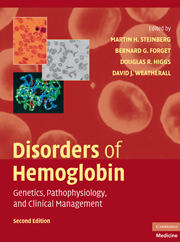Book contents
- Frontmatter
- Contents
- List of Contributors
- Foreword, by H. Franklin Bunn
- Preface
- Introduction, by David J. Weatherall
- SECTION ONE THE MOLECULAR, CELLULAR, AND GENETIC BASIS OF HEMOGLOBIN DISORDERS
- 1 A Developmental Approach to Hematopoiesis
- 2 Erythropoiesis
- 3 The Normal Structure and Regulation of Human Globin Gene Clusters
- 4 Nuclear Factors That Regulate Erythropoiesis
- 5 Molecular and Cellular Basis of Hemoglobin Switching
- 6 Structure and Function of Hemoglobin and Its Dysfunction in Sickle Cell Disease
- 7 Hemoglobins of the Embryo, Fetus, and Adult
- SECTION TWO PATHOPHYSIOLOGY OF HEMOGLOBIN AND ITS DISORDERS
- SECTION THREE α THALASSEMIA
- SECTION FOUR THE β THALASSEMIAS
- SECTION FIVE SICKLE CELL DISEASE
- SECTION SIX OTHER CLINICALLY IMPORTANT DISORDERS OF HEMOGLOBIN
- SECTION SEVEN SPECIAL TOPICS IN HEMOGLOBINOPATHIES
- SECTION EIGHT NEW APPROACHES TO THE TREATMENT OF HEMOGLOBINOPATHIES AND THALASSEMIA
- Index
- Plate section
- References
1 - A Developmental Approach to Hematopoiesis
from SECTION ONE - THE MOLECULAR, CELLULAR, AND GENETIC BASIS OF HEMOGLOBIN DISORDERS
Published online by Cambridge University Press: 03 May 2010
- Frontmatter
- Contents
- List of Contributors
- Foreword, by H. Franklin Bunn
- Preface
- Introduction, by David J. Weatherall
- SECTION ONE THE MOLECULAR, CELLULAR, AND GENETIC BASIS OF HEMOGLOBIN DISORDERS
- 1 A Developmental Approach to Hematopoiesis
- 2 Erythropoiesis
- 3 The Normal Structure and Regulation of Human Globin Gene Clusters
- 4 Nuclear Factors That Regulate Erythropoiesis
- 5 Molecular and Cellular Basis of Hemoglobin Switching
- 6 Structure and Function of Hemoglobin and Its Dysfunction in Sickle Cell Disease
- 7 Hemoglobins of the Embryo, Fetus, and Adult
- SECTION TWO PATHOPHYSIOLOGY OF HEMOGLOBIN AND ITS DISORDERS
- SECTION THREE α THALASSEMIA
- SECTION FOUR THE β THALASSEMIAS
- SECTION FIVE SICKLE CELL DISEASE
- SECTION SIX OTHER CLINICALLY IMPORTANT DISORDERS OF HEMOGLOBIN
- SECTION SEVEN SPECIAL TOPICS IN HEMOGLOBINOPATHIES
- SECTION EIGHT NEW APPROACHES TO THE TREATMENT OF HEMOGLOBINOPATHIES AND THALASSEMIA
- Index
- Plate section
- References
Summary
INTRODUCTION AND GENERAL CONSIDERATIONS
During mammalian development, the first morphologically recognizable blood cells in the conceptus are those of the erythroid lineage. The early production of erythroid lineage cells in the yolk sac is required for the development of the vertebrate embryo. These blood cells are short-lived, however. In contrast, long-term adult hematopoiesis results from a complex cell lineage differentiation hierarchy that produces at least eight functionally distinct lineages of differentiated blood cells. The founder cells for this hierarchy are the hematopoietic stem cells (HSCs), which undergo progressive differentiation, proliferation, and restriction in lineage potential. The adult blood system is constantly replenished throughout adult life from rare HSCs harbored in the bone marrow. The field of “developmental hematopoiesis” investigates how this complex adult system is generated in the conceptus. Current research interests in this field include 1) the embryonic origins, cell lineage relationships, and functions of the cells within the multiple embryonic hematopoietic compartments; 2) the changing developmental microenvironments that support hematopoietic (stem) cell growth; and 3) the molecular programming of the hematopoietic system during ontogeny. This chapter will focus on our current knowledge concerning the embryonic beginnings of the adult hematopoietic system. Insights emerging from such a developmental approach should lead to novel molecular and cellular manipulations that could aid in the ex vivo generation and/or expansion of HSCs and progenitors for clinical use in transplantations for leukemias or blood-related genetic disease.
- Type
- Chapter
- Information
- Disorders of HemoglobinGenetics, Pathophysiology, and Clinical Management, pp. 3 - 23Publisher: Cambridge University PressPrint publication year: 2009



